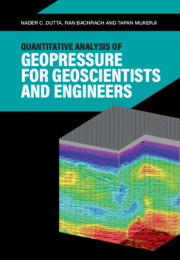Book contents
- Quantitative Analysis of Geopressure for Geoscientists and Engineers
- Quantitative Analysis of Geopressure for Geoscientists and Engineers
- Copyright page
- Contents
- Preface
- 1 Basic Pressure Concepts and Definitions
- 2 Basic Continuum Mechanics and Its Relevance to Geopressure
- 3 Mechanisms of Geopressure
- 4 Quantitative Geopressure Analysis Methods
- 5 Seismic Methods to Predict and Detect Geopressure
- 6 Integrating Seismic Imaging, Rock Physics, and Geopressure
- 7 Methods for Pore Pressure Detection
- 8 Gravity and EM Field Methods Aiding Pore Pressure Prediction
- 9 Geopressure Detection and Prediction in Real Time
- 10 Geopressure Prediction Using Basin History Modeling
- 11 Geohazard Prediction and Detection
- 12 Petroleum Geomechanics and the Role of Geopressure
- 13 Guidelines for Best Practices
- 14 Recent Advances in Geopressure Prediction and Detection Technology and the Road Ahead
- Book part
- References
- Index
3 - Mechanisms of Geopressure
Published online by Cambridge University Press: 10 February 2021
- Quantitative Analysis of Geopressure for Geoscientists and Engineers
- Quantitative Analysis of Geopressure for Geoscientists and Engineers
- Copyright page
- Contents
- Preface
- 1 Basic Pressure Concepts and Definitions
- 2 Basic Continuum Mechanics and Its Relevance to Geopressure
- 3 Mechanisms of Geopressure
- 4 Quantitative Geopressure Analysis Methods
- 5 Seismic Methods to Predict and Detect Geopressure
- 6 Integrating Seismic Imaging, Rock Physics, and Geopressure
- 7 Methods for Pore Pressure Detection
- 8 Gravity and EM Field Methods Aiding Pore Pressure Prediction
- 9 Geopressure Detection and Prediction in Real Time
- 10 Geopressure Prediction Using Basin History Modeling
- 11 Geohazard Prediction and Detection
- 12 Petroleum Geomechanics and the Role of Geopressure
- 13 Guidelines for Best Practices
- 14 Recent Advances in Geopressure Prediction and Detection Technology and the Road Ahead
- Book part
- References
- Index
Summary
This chapter describes the basic mechanisms that give rise to subsurface excess fluid pore pressure. These mechanisms include rapid deposition where the fluid cannot escape as the sediments are deposited, giving rise to excess pore pressure. This is known as disequilibrium compaction. Other mechanism are also described, including chemical diagenesis, kerogen maturation, aquathermal pressuring, and hydrocarbon buoyancy effects.
Keywords
- Type
- Chapter
- Information
- Publisher: Cambridge University PressPrint publication year: 2021

